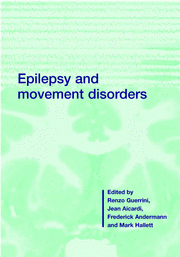Book contents
- Frontmatter
- Contents
- List of contributors
- Preface and overview
- 1 Epilepsies as channelopathies
- 2 Epilepsy and movement disorders in the GABAA receptor β3 subunit knockout mouse: model of Angelman syndrome
- 3 Genetic reflex epilepsy from chicken to man: relations between genetic reflex epilepsy and movement disorders
- 4 Functional MRI of the motor cortex
- 5 Neuromagnetic methods and transcranial magnetic stimulation for testing sensorimotor cortex excitability
- 6 Motor dysfunction resulting from epileptic activity involving the sensorimotor cortex
- 7 Nocturnal frontal lobe epilepsy
- 8 Motor cortex hyperexcitability in dystonia
- 9 The paroxysmal dyskinesias
- 10 Normal startle and startle-induced epileptic seizures
- 11 Hyperekplexia: genetics and culture-bound stimulus-induced disorders
- 12 Myoclonus and epilepsy
- 13 The spectrum of epilepsy and movement disorders in EPC
- 14 Seizures, myoclonus and cerebellar dysfunction in progressive myoclonus epilepsies
- 15 Opercular epilepsies with oromotor dysfunction
- 16 Facial seizures associated with brainstem and cerebellar lesions
- 17 Neonatal movement disorders: epileptic or non-epileptic
- 18 Epileptic and non-epileptic periodic motor phenomena in children with encephalopathy
- 19 Epileptic stereotypies in children
- 20 Non-epileptic paroxysmal eye movements
- 21 Shuddering and benign myoclonus of early infancy
- 22 Epilepsy and cerebral palsy
- 23 Sydenham chorea
- 24 Alternating hemiplegia of childhood
- 25 Motor attacks in Sturge–Weber syndrome
- 26 Syndromes with epilepsy and paroxysmal dyskinesia
- 27 Epilepsy genes: the search grows longer
- 28 Genetics of the overlap between epilepsy and movement disorders
- 29 Seizures and movement disorders precipitated by drugs
- 30 Steroid responsive motor disorders associated with epilepsy
- 31 Drugs for epilepsy and movement disorders
- Index
- Plate section
22 - Epilepsy and cerebral palsy
Published online by Cambridge University Press: 03 May 2010
- Frontmatter
- Contents
- List of contributors
- Preface and overview
- 1 Epilepsies as channelopathies
- 2 Epilepsy and movement disorders in the GABAA receptor β3 subunit knockout mouse: model of Angelman syndrome
- 3 Genetic reflex epilepsy from chicken to man: relations between genetic reflex epilepsy and movement disorders
- 4 Functional MRI of the motor cortex
- 5 Neuromagnetic methods and transcranial magnetic stimulation for testing sensorimotor cortex excitability
- 6 Motor dysfunction resulting from epileptic activity involving the sensorimotor cortex
- 7 Nocturnal frontal lobe epilepsy
- 8 Motor cortex hyperexcitability in dystonia
- 9 The paroxysmal dyskinesias
- 10 Normal startle and startle-induced epileptic seizures
- 11 Hyperekplexia: genetics and culture-bound stimulus-induced disorders
- 12 Myoclonus and epilepsy
- 13 The spectrum of epilepsy and movement disorders in EPC
- 14 Seizures, myoclonus and cerebellar dysfunction in progressive myoclonus epilepsies
- 15 Opercular epilepsies with oromotor dysfunction
- 16 Facial seizures associated with brainstem and cerebellar lesions
- 17 Neonatal movement disorders: epileptic or non-epileptic
- 18 Epileptic and non-epileptic periodic motor phenomena in children with encephalopathy
- 19 Epileptic stereotypies in children
- 20 Non-epileptic paroxysmal eye movements
- 21 Shuddering and benign myoclonus of early infancy
- 22 Epilepsy and cerebral palsy
- 23 Sydenham chorea
- 24 Alternating hemiplegia of childhood
- 25 Motor attacks in Sturge–Weber syndrome
- 26 Syndromes with epilepsy and paroxysmal dyskinesia
- 27 Epilepsy genes: the search grows longer
- 28 Genetics of the overlap between epilepsy and movement disorders
- 29 Seizures and movement disorders precipitated by drugs
- 30 Steroid responsive motor disorders associated with epilepsy
- 31 Drugs for epilepsy and movement disorders
- Index
- Plate section
Summary
Introduction
From an everyday clinical point of view, the management of cerebral palsy demands an understanding of the epilepsy which commonly co-occurs. A prelude to such management is ensuring the correctness of both the diagnosis of cerebral palsy and the diagnosis of epilepsy.
Definitions
The definitions of epileptic seizures, symptomatic epileptic seizures, and epilepsy are as generally recognized (Stephenson, 1990; Engel & Pedley, 1997), as is the definition of anoxic seizures (Stephenson & McLeod, 2000). Movement disorders are paroxysmal disorders of movement which are the result neither of epileptic nor anoxic seizures.
Cerebral palsy is generally defined as ‘a persistent disorder of movement and posture caused by nonprogressive defects or lesions of the immature brain’ (Aicardi & Bax, 1998).
Clinical imitators of cerebral palsy
It is increasingly realized that what superficially appears to be cerebral palsy in an infant may be the result of a rare treatable biochemical error, such as glucose transporter (GLUT 1) deficiency, guanidinoacetate methyltransferase deficiency with creatine deficiency, argininemia, or one of the defects in serine biosynthesis. In all these conditions epileptic seizures may co-occur. Other rare biochemical mimics include disorders of purine and pyrimidine metabolism, and organic acid disorders such as 3-methylcrotonyl-CoA carboxylase deficiency.
Hyperekplexia is an example of an ion channelopathy in which the young infant is variably hypertonic, with non-epileptic convulsions giving profound syncopes.
The autosomal recessive Aicardi–Goutières syndrome may appear to be clinically static, but the cerebral lesions are slowly progressive.
We emphasize these points because the care of young patients with cerebral palsy is often undertaken by pediatricians with no special training in neurology.
- Type
- Chapter
- Information
- Epilepsy and Movement Disorders , pp. 353 - 358Publisher: Cambridge University PressPrint publication year: 2001



